Diesel Service Report, Sept 5th, 2020
ATSF 560 Fairbanks Morse
Our FM H12-44M locomotive was started for the first time in 30 years. Once it was running, the commutators in the main generator, and auxiliary and exciter generators were cleaned. Then the brakes were tested. Once that was all complete, the locomotive moved back and forth under its own power. This accomplishment was required before we could make the decision to go ahead with the refurbishment project. As of now, the refurbishment project will proceed.
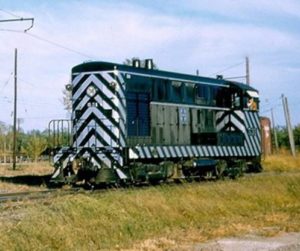 A project fund has been established at the museum. It is the M56 fund. The estimate to complete the refurbishment, including painting, is $40,000. The paint scheme has not been selected yet. We will let the donors make that decision. There are two paint schemes being considered. One is called the Black and Silver (or aluminum) Zebra Stripe scheme and the other is the Blue and Yellow Kodachrome scheme.
A project fund has been established at the museum. It is the M56 fund. The estimate to complete the refurbishment, including painting, is $40,000. The paint scheme has not been selected yet. We will let the donors make that decision. There are two paint schemes being considered. One is called the Black and Silver (or aluminum) Zebra Stripe scheme and the other is the Blue and Yellow Kodachrome scheme.
The plan is to ask the donors to pick which color scheme they would like to see and assign one point to that scheme for each dollar donated. When we are ready to paint the locomotive, we will add up the accumulated points and pick the winner.
We are now ready to accept donations for the project and ask that you identify which color scheme you would like to see on the locomotive. Please identify your donation for project M56, Fairbanks Morse Restoration.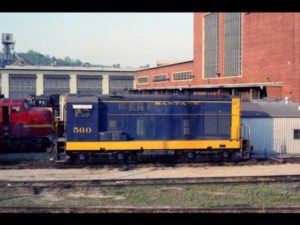
For those of you that have already donated, please let me know your choice of color schemes and I’ll put it on the list.
Thank you. Now let’s make this happen.
There is only one other locomotive of this exact model in existence, so this is an exceedingly rare and important piece of railroad history. It runs so now let’s finish the job. A detailed report on the project is included further below.
USAF 1601
A few months ago, we purchased a complete replacement truck for 1601 using donations from Doug Newberry and one other member. That truck had two running-take-out traction motors, which is what we needed. The complete truck cost us less than buying just the two motors by themselves. From a cost point of view, it was a good deal. After Doug and Carl Pickus proved the gear ratios were the same between the new gear cases and the old ones, it was decided to install the complete gear-case and motor combinations. Doug, Carl, and Frank Kunsaitis made that swap. In the process, several problems were found with the existing trucks, so those issues were addressed at the same time. Some of the needed parts are still on order. Until now, the rebuilt trucks were not put back under the locomotive.
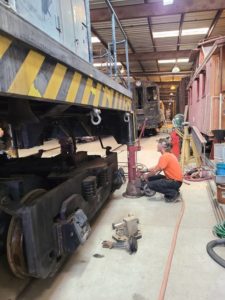
However, 1601 was on jacks with no trucks underneath. And our Fairbanks Morse SF560 locomotive was blocked from moving out of the barn. The decision was made to lower 1601 back onto its trucks, temporarily, so that it could be moved to allow 560 to go outside for its initial starting. While moving the trucks back under 1601, Carl and Frank noticed a large amount of play in one axle as it came out of the gear case. Obviously, the output bearing in the gear case, on that side, is totally ruined.
This (left) shows the locomotive as it is being lowered with the jacks. Frank is watching to make sure everything is staying level as the locomotive is lowered.
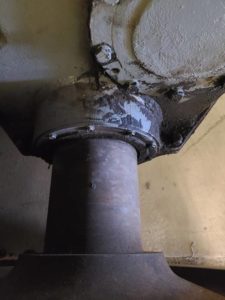
There is no way to easily replace the bad bearing and there is a possibility that the axle could be damaged also. That leaves us almost with no option other than to remove the faulty gear case wheel set combination and replace it with one that was previously removed from under 1601. Of course, the new traction motor will need to be installed onto the original gear case.
This picture (right) shows the axle as it comes out of the gear case. When moving the wheels, the axle was moving in the gear case output upwards of .25”. It should have no play at all in that area.
Near term, the locomotive will be parked behind SF560 and work will commence in October when we have the personnel available to tackle it.
SP1474
For years, 1474 has had intermittent issues with transitioning to higher speeds. We were never able to pinpoint the problem. Now another problem has come up. When the locomotive attempts to transition, it no longer loads properly. Most likely it’s an intermittent interlock contact but at least it should be easy to find as long as the problem stays there.
OERM 1975
Last winter, rain found its way into one of the journal boxes and essentially flushed out all the lubricating oil. The problem wasn’t noticed until the axle bearing started smoking. By then the Babbitt bearing had melted some of its soft bearing material and the bearing needs to be replaced. We purchased three used bearing a couple of years ago, but they need to be resurfaced. They are in the machine shop waiting to be machined. Until that is done, the locomotive is Red Tagged and only approved for limited moves.
USAF 7441
Tom Platten has fabricated new arm rests for the windows. He and Bob Bray and Tim Johnson continued to work on the cab getting it ready for painting. Earlier this year we had continuous problems with the engine going into run-away when first started. We heard that it was caused by leaking seals around a fuel pump shaft. Those seals were replaced and the running away problem has not happened since. Hopefully that problem has been solved.
SP3100
The locomotive is on the operational roster and has been working great. Recently a fuel tank level sight glass was accidentally damaged and needed to be replaced. Fortunately, we had an exact replacement in stock. It was installed and there is no restriction on the locomotive use now.
Diesel Locomotive Testing Load Bank
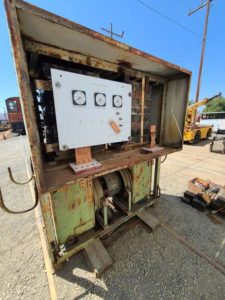
Our rebuild of a load bank is progressing. The jumper cable material and terminals have been purchased. The control panel has been installed and the main remaining task is the internal wiring. Once the unit is complete, we will be able to test the locomotives under high power. The main power generator in the locomotive will have cables that feed its electrical power to the load bank rather than to traction motors. The load bank is being built to handle up to 2000 amps at 1000 volts. That equates to about 2,600 hp. However, the use of the load bank is not to prove how much power the locomotives can produce. There is no need to push the locomotives to their limit. The intent is to operate them at high enough power levels to clean out the exhaust systems and keep them operating smoothly and clean.
This is the view of the load bank control panel. Behind the control panel are 15 high power resistors that will dissipate the heat generated during testing. Below the control panel is a very large blower. It has a 64 hp motor that can operate up to 325 volts. That voltage is taken off of the power resistors. That means that the power from the locomotive not only goes to the resistors, but also runs the cooling fan. This will be an interesting thing to watch. We have never had one before. But it is especially important for keeping locomotive Diesel engines running properly. Especially 2 cycle engines such as used in SF108, UP942, SP1006, and SF560.
SF560 Fairbanks Morse Refurbishment Project
First, we want to thank those volunteers that have worked so hard getting this locomotive ready. They are: Doug Newberry, Carl Pickus, Frank Kunsaitis, Richard Berk, John Salvini, and others that pitched in.
Thirty years ago, we started and operated the locomotive. Then it was drained of coolant and sat idle until recently. After the SW1, SP1006 project was completed, we decided that SF560, our Fairbanks Morse H12-44M locomotive, was next for refurbishment. But that project could only go ahead if we could prove that the Diesel engine and main generator were functional. That was proven yesterday. So, the refurbishment project can now proceed.
To reach this point, we needed to prove that we had a high probability of being able to accomplish the project without needing inordinate amounts of funding. If there was anything wrong with the Diesel engine or main generator, the repair costs could be prohibitive and the project most likely would not proceed.
Thanks to a generous donation from Evan Werkema, we had just enough funding to complete the investigation process. Videos documenting the successful initial start-up of the Diesel engine were posted on the SCRM Diesel Shop Facebook page. Check them out. The start-up video is pretty exciting.
To get ready for the start-up, a lot of work had to be done. A special thanks goes to John Salvini for his relentless efforts cleaning out the air box, blower, exhaust system, and mufflers. It took many hours of very dirty work in hard to access places. And it was worth it.
He removed gallons of oil from the air box areas, exhaust chambers, and blower. He removed over 50 lbs of chunky carbon from the exhaust mufflers, called snubbers. Those chunks are essentially coal and can catch fire if the engine is heavily loaded.
We had found that all 12 fuel injection fuel pumps were frozen. The barrels in the pumps had been pushed down by the cam shaft but would not pop back up again. As a result, no fuel could be routed to the injectors. Richard Berk was able to arrange a trade of our frozen pumps for 12 other used pumps that had recently been removed from an operating engine. Those pumps were installed and calibrated.
The existing injector nozzles are an obsolete design and no spare parts are available. A nozzle tester was built, and all 12 nozzles were tested. Their spray patterns weren’t perfect but was adequate. Since there are two nozzles for each cylinder, if one isn’t working perfectly, the odds are that the other one will work and the cylinder will still fire.
As an example of the costs associated with Fairbanks Morse engines, a small calibrated tool for adjusting the fuel pumps was $450. That was in the range of what we could afford but demonstrates the ultra-high costs for anything associated with Fairbanks Morse. Fortunately, the rest of the locomotive uses standard parts that are typically affordable if needed.
Before starting the locomotive, a faulty coolant drain valve had to be replaced. New fuel filters installed. Old fuel was removed from the fuel tank and new fuel added. The oil levels in the engine and air compressor were checked and the blower fresh air inlet filters cleaned. Of course this took a few months.
Then it was time to start the locomotive. When new fuel pumps are installed, fuel in the lines going from the injection pumps to the injection nozzles is drained. When the system fuel supply pump is turned on, it clears the air out of the main fuel supply lines and the injection pump, but not the line from the pump to the nozzle. Initially it takes some engine cranking to refill those lines. Once they are full, the pressure to the injection nozzles will exceed 1500 psi and the nozzle will open and spray fuel into the cylinder between the two piston heads. The air in the chamber has then been compressed so much that it is extremely hot. When the fuel is sprayed into that hot air, the fuel will automatically ignite. But when a system is first being started, a lot of fuel gets injected before all the cylinders are primed and ready to fire. However, in the process, black smoke will come out the exhaust stack. Then when the cylinders do finally start to fire correctly, the unburned atomized fuel in the exhaust system will catch fire in a spectacular show of a fire ball billowing high out the stack with a loud boom. It’s a major escalation of the term “backfire” as usually applied to automobiles.
After the fuel system is primed, it stays primed as long as there is no leakage in the pipes. Then when its time to start the engine again, it will fire in just a few revolutions and very little smoke is created as it starts to run. Once the engine was idling, there was no smoke coming out of the exhaust stack at all. And there was no evidence of oil being spit out the exhaust stack.
Now begins the rest of the work for the restoration. The end goal of course is painting. But before that can happen, there will be months of work spent cleaning up the engine compartment, trucks, cab, etc. In addition, numerous, non-professional looking, modifications had been made over the years in the engine compartment. Those all need to be removed and made to look correct.
The exhaust snubbers, essentially mufflers, must be removed to repair damage to their mounting brackets and to clean out the rest of the coke that is still inside them. That will also give us access to that end of the engine block for cleaning and replacement of a leaking seal off the end of the upper crankshaft. Of course, almost every hand cover on the engine block leaks oil, so all of those gaskets need to be replaced.
One of the more important tasks is the design and installation of an electrical contactor system to operate the radiator cooling fan. Originally the fan was a mechanically driven fan using a stub shaft which was driven off the end of the upper crankshaft. That system was removed before the engine came to the museum. An electric fan was installed but with no means to operate it. We will install a thermostat switch and contactor and operate the fan using 75 volts from the battery system.
There are no windows in the cab. The glass is all missing. The plan will be to cut temporary panels using Lexan and then install real glass after the locomotive is painted.
In summary, there is a lot of work to still do. But most of it can be done by volunteers. But there will be costs associated with required parts, new windows and painting. This all has to be done with donations. Donations should be noted for use on program M56, Fairbanks Morse Restoration.
In addition to making the donation, please note which paint scheme you would like to see. Prior to painting, we will add up all of the paint scheme selections and decide which one will be used based on the level of donations.
Dave Althaus

